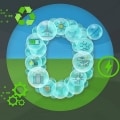The natural gas utility workforce in a decarbonizing world has been saved

Perspectives
The natural gas utility workforce in a decarbonizing world
Explore a framework for mapping growth in the clean energy future
What opportunities can natural gas utilities and their workforces seize today to prepare to be more sustainable over the next decade and beyond? Explore how natural gas utilities can strategically position themselves for growth, what skills their workforces may need to implement these strategies, and how they can bridge the gap between current and future workforce needs.
Explore content
- Setting up the future of natural gas for success
- Renew, reshape, refuel: Natural gas utility decarbonization framework
- Utilities should address workforce skills gaps to seize the sustainability opportunities
- Utilities focused on sustainability could be best positioned to attract and train talent
- Looking to the future of natural gas with sustainability as a key enabler
Setting up the future of natural gas for success
Natural gas has played an important role in reducing US carbon emissions over the past several decades by replacing coal and balancing intermittent renewables in power generation and by more efficient and direct delivery to homes and businesses. While the power sector continues to drive an economywide decarbonization based on a record deployment of renewable electrons, natural gas utilities are uniquely positioned to deliver cleaner molecules than today’s natural gas and other fossil fuels to residential, commercial, and industrial customers seeking to lower their emissions. The utilities and their stakeholders are exploring how they can deploy their infrastructure, new technologies, and skilled workforces as an integral part of America’s clean energy future while enhancing resilience and maintaining customer choice at a lower cost.
Renew, reshape, refuel: Natural gas utility decarbonization framework
We’ve developed a utility decarbonization framework encompassing three trends and three strategies that gas utilities can pursue to lower their carbon emissions.
Three cost-cutting trends are shaping gas utility decarbonization opportunities:
- Fossil fuel use is being reduced as carbon emission budgets align with pathways to limit global warming to 1.5 degrees Celsius.
- A hydrogen hike, buoyed by the new federal production tax credit and funding for hydrogen hubs, is making clean hydrogen use more competitive.
- Infrastructure innovation is enabling the gas system to flexibly integrate different molecules into its energy networks.
What follows are three value-creating strategies that utilities may want to consider deploying to capitalize on the three trends:
- Renew supply by mainstreaming carbon-free sources. This involves retiring or retrofitting nonrenewable energy sources by ramping up renewable natural gas (RNG) and ramping down carbon releases by improving leak detection and capturing any emissions. Another alternative to geological gas—hydrogen—can be blended up to 15% with methane without requiring significant pipeline upgrades.1 The renew strategy is mostly deployable over the next decade given that the technologies involved in modernizing molecules are established or evolving.
- Reshape demand by harnessing behind-the-meter sources. Load shifting can help mitigate both electric and gas demand peaks and enable homeowners with hybrid appliances to switch based on price signals. Microgrids can also help shift load while deploying hydrogen as a distributed energy resource. Significantly expanded energy-efficiency measures could further optimize the network by avoiding the production of any superfluous molecules. Evolving and emerging technologies in the reshape strategy could have a greater impact in the 2030–2040 time frame.
- Refuel by entering new markets. Net-zero gases could replace liquids in segments that are hard to electrify, such as long-distance road, railroad, aviation, and maritime transportation, in addition to buildings. Hydrogen deployment to appliances could be achieved through participation in hydrogen hubs bringing together numerous hydrogen producers, distributors, and off-takers in one location. As hydrogen production expands beyond hubs and direct air capture technology matures, natural gas utilities could develop new pipeline networks dedicated to transporting these molecules (as well as retrofitting existing infrastructure). The refuel strategy is still emerging and has a longer runway to mature by 2040–2050, when it is expected to be most needed.
Utilities should address workforce skills gaps to seize the sustainability opportunities
Workforce skill requirements are growing in many of the positions that utilities tend to have the most difficulty filling. The core natural gas utility workforce is well positioned to transition to adjacent roles in the three industries taking off over the next decade in the renew strategy. Indeed, the natural gas utility workforce shares most of its core roles with the RNG, geothermal, and hydrogen industries.2 All four include mechanical and electrical engineers, and the geothermal and RNG industries include pipefitters, mechanics, and welders. Utilities that build the capabilities now may be positioned to take on a renew strategy.
Beyond these roles, the natural gas utility, RNG, geothermal, and hydrogen industries also share skills across their whole workforces. Preparing to use more green hydrogen further involves roles that do not yet exist. An analysis of these roles suggests that the emerging hydrogen economy will likely offer the core natural gas workforce many opportunities to transfer into new roles across decarbonization strategies.3
Renew, reshape, and refuel efforts could accelerate digitalization and digital skill requirements as utilities automate pipeline leakage detection, secure pipelines from cyberthreats, and possibly use blockchain to track the environmental attributes of the molecules they transport.
Utilities focused on sustainability could be best positioned to attract and train talent
The energy sector is decarbonizing and digitalizing in varying degrees, but utilities willing to champion these intertwined trends could be more attractive to prospective employees. Gas utilities could differentiate from other energy companies they see as their greatest competitors in attracting talent. As energy carriers, they have greater leeway than the competition in recasting themselves as carbon-free fuel networks advancing the energy transition, green hydrogen economy, and digital future.
Looking to the future of natural gas with sustainability as a key enabler
Surveyed natural gas utilities see pipeline renewal and expansion and customer growth as drivers of workforce growth and talent attraction. Less apparent is that sustainability is a key enabler. Utilities with ambitious decarbonization strategies can amplify growth in three ways.
First, use core workforce skills and infrastructure to enable larger RNG, geothermal, and hydrogen industries. Second, successfully transition the workforce to new roles and digital skills. And third, embrace decarbonization goals and a training-based workplace to attract talent away from competitors. Gas utilities have a key role to play in closing the molecule, skill, and training gaps to help enable America’s clean energy future.
If you’d like to talk more about the natural gas utility landscape and how your company can better address workforce skills gaps, let’s set up a conversation.
Endnotes
1 Paul W. Parfomak, Pipeline transportation of hydrogen: Regulation, research, and policy, Congressional Research Service, March 2, 2021.
2 Burning Glass Technologies analysis.
3 Analysis based on BLS and ONET data and WorkingNation’s description of future hydrogen roles.
Explore content
- Setting up the future of natural gas for success
- Renew, reshape, refuel: Natural gas utility decarbonization framework
- Utilities should address workforce skills gaps to seize the sustainability opportunities
- Utilities focused on sustainability could be best positioned to attract and train talent
- Looking to the future of natural gas with sustainability as a key enabler
Recommendations
Utility decarbonization strategies
A utility decarbonization framework to renew supply, reshape demand, and refuel end uses.
The decarbonized power workforce
Decarbonization by 2035 could be a catalyst for workforce transformation. The future is digital, and power companies should act now to tap into new talent pools.





